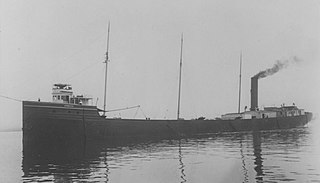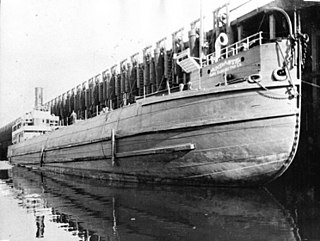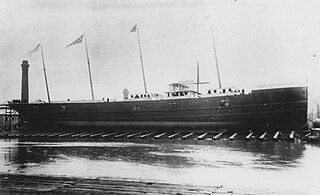
Joseph L. Hurd was a wooden steam ship built in Detroit, Michigan, in 1869. [1]

Joseph L. Hurd was a wooden steam ship built in Detroit, Michigan, in 1869. [1]
The Joseph L. Hurd was first enrolled in Detroit on September 15, 1869, [1] starting on the Detroit and Saginaw route. [2] She later collided with SS Cayuga in 1895, sinking the newer steel ship and killing one crew member. [3] The Joseph L. Hurd started carrying stone in October 1904, [2] and she became a barge in 1907. [1]
Joseph L. Hurd was beached in Sturgeon Bay in September 1913 and subsequently abandoned by its crew. [2]

SS Republic was a sidewheel steamship, originally named SS Tennessee, lost in a hurricane off the coast of Georgia in October 1865, en route to New Orleans.

City of Bangor was a freighter that had a 30-year career on the Great Lakes. Originally designed to carry ore, the ship was converted into an automobile carrier in 1925. She was trapped in ice on Lake Superior November 30, 1926, and after multiple salvage attempts, Bangor was declared a total loss.

The SS Appomattox was a wooden-hulled, American Great Lakes freighter that ran aground on Lake Michigan, off Atwater Beach off the coast of Shorewood, Wisconsin in Milwaukee County, Wisconsin, United States in 1905. On January 20, 2005 the remnants of the Appomattox were listed on the National Register of Historic Places.

SS Daniel J. Morrell was a 603-foot (184 m) Great Lakes freighter that broke up in a strong storm on Lake Huron on 29 November 1966, taking with her 28 of her 29 crewmen. The freighter was used to carry bulk cargoes such as iron ore but was running with only ballast when the 60-year-old ship sank.

SS John B. Cowle was one of the early Great Lakes bulk freighters known as "tin pans". She was the first of two ships named for prominent Cleveland, Ohio citizen and shipbuilder John Beswick Cowle. In 1909 on her maiden voyage SS Isaac M. Scott rammed John B. Cowle in heavy fog off Whitefish Point. John B. Cowle sank in three minutes, taking 14 of her 24-man crew with her. Artifacts from her wreck were illegally removed in the 1980s. Her artifacts are now the property of the State of Michigan and are on display as a loan to the Great Lakes Shipwreck Museum. The wreck of John B. Cowle is protected as part of an underwater museum in the Whitefish Point Underwater Preserve.

Lady Elizabeth was a British ship built in 1869 by Robert Thompson Jr. of Sunderland. Robert Thompson Jr. was one of the sons of Robert Thompson Sr. who owned and operated the family ran shipyard J. L. Thompson & Sons. Thompson Jr. eventually left the family business in 1854 to start his own shipbuilding business in Southwick, Sunderland. She was 658 tons and was classified as a barque cargo sailing ship with one deck and three masts. She had a keel and outer planking made from American rock elm and a fore end made from English elm. The stem was made of teak and English oak with an iron floor as the deck. The ship also had copper and iron fastings. The ships was also registered in London under the name Wilson & Co. Messrs Wilson & Co. was based out of Sydney, Australia. The ship carried a comparative classification under American Lloyd's as "First class-third grade"

L.R. Doty was a Great Lakes steamship launched in May 1893 at West Bay City, Michigan. She was last seen afloat October 25, 1898 north of Milwaukee, Wisconsin, during a violent storm on Lake Michigan, with winds reaching 70 miles per hour (110 km/h). The ship was witnessed foundering at the stern by a passenger of the four-masted schooner Olive Jeanette which was being towed by the Doty until the tow line broke from the force of the storm. Seventeen crew members died.

The Ocean Wave was a scow schooner that sank in Lake Michigan off the coast of Door County, Wisconsin, United States. In 2006 the shipwreck site was added to the National Register of Historic Places.

R. J. Hackett was a steamer built in 1869. When first launched, the ship's wide cross-section and long midships hold were unconventional, but the design's advantages in moving cargo through the inland lakes spawned many imitators. The Hackett is recognized as the first Great Lakes freighter, a vessel type that has dominated Great Lakes shipping for over 100 years. In 1905, the Hackett caught fire and sank on Whaleback Shoal in Green Bay, 9.5 miles (15.3 km) southeast of the Cedar River in Menominee County, Michigan. The wreck site was listed on the National Register of Historic Places in 1992.

SS Clifton, originally Samuel Mather, was a whaleback lake freighter built in 1892 for service on the Great Lakes. She was 308 foot (94 m) long, 30 foot (9.1 m) beam, and 24 foot (7.3 m) depth, and had a 3,500 ton capacity. The self-propelled barge was built by the American Steel Barge Company in West Superior, Wisconsin. Her builders used a design well-suited to carry iron ore, her intended trade. The new vessel was christened Samuel Mather, after a cofounder of Pickands Mather and Company, which at the time was the second largest fleet on the Great Lakes.

The SS Andaste was a semi-whaleback freighter, built in 1892 by the Cleveland Ship Building Company for the Lake Superior Iron Company. The vessel is best known for sinking on Lake Michigan on the night of September 9–10, 1929, with all hands; 25 men were lost. As of 2020, the wreck of Andaste has not yet been located.

SS Choctaw was a steel-hulled American freighter in service between 1892 and 1915, on the Great Lakes of North America. She was a so-called monitor vessel, containing elements of traditional lake freighters and the whaleback ships designed by Alexander McDougall. Choctaw was built in 1892 by the Cleveland Shipbuilding Company in Cleveland, Ohio, and was originally owned by the Lake Superior Iron Company. She was sold to the Cleveland-Cliffs Iron Company in 1894 and spent the rest of her working life with it. On her regular route between Detroit, Escanaba, Marquette, and Cleveland, she carried iron ore downbound, and coal upbound.

The Australasia was a wooden-hulled American Great Lakes freighter that served on the Great Lakes of North America between her construction in 1884 to her burning and sinking in 1896. On October 18, 1896, while loaded with coal, the Australasia sank in Lake Michigan near the town of Sevastopol, Door County, Wisconsin, United States, after burning off Cana Island. On July 3, 2013, the wreck of the Australasia was added to the National Register of Historic Places.

Antelope was a Great Lakes steamship that later was converted into a schooner barge) and sank in Lake Superior near the Apostle Islands in 1897.

PS Lotta Bernard was a wooden-hulled sidewheel steam barge that served on the Great Lakes from her construction in 1869 to her sinking in 1874. She was built in Port Clinton, Ohio, in 1869 by Lewis M. Jackson for S.W. Dorsey of Sandusky, Ohio. When she entered service, she was chartered by the Northern Transportation Company to carry cordwood from the Portage River and Put-in-Bay to Cleveland, Ohio. In 1870, Lotta Bernard was sold to Luman H. Tenney of Duluth, Minnesota. During this time, she was contracted to haul building materials from Bark Bay, Wisconsin, to Duluth to be used in the construction of the first grain elevator in that port. Lotta Bernard was sold to John D. Howard of Superior, Wisconsin, in 1871.

SS Russia was an iron-hulled American Great Lakes package freighter that sank in a Lake Huron gale on April 30, 1909, near DeTour Village, Michigan, with all 22 of her crew and one passenger surviving.

SS Vernon was a wooden-hulled American passenger and package freighter that sank in a Lake Michigan storm on October 29, 1887, near Two Rivers, Wisconsin, with the loss of between 36 and 50 lives, making her one of the deadliest shipwrecks ever to have occurred in Wisconsin. Only one of the people on board survived.

SS Cayuga was a steel-hulled American package freighter in service between 1889 and 1895. She was built in 1889 in Cleveland, Ohio, by the Globe Iron Works Company for the Lehigh Valley Transit Company of Buffalo, New York. One of five identical sister ships, Cayuga entered service in 1889, carrying package freight between Buffalo and Chicago, Illinois, also making stops in Milwaukee, Wisconsin, and Gladstone, Michigan. Prior to her sinking, Cayuga was involved in two accidents. In the first in 1890, when she went aground in a gale just outside of Buffalo harbour; six tugboats managed to pull her free that same day. The second accident occurred in 1891, when Cayuga was involved in a collision with the package freighter Delaware near Cheboygan, Michigan.

SS Ironsides was a wooden-hulled American package freighter in service between 1864 and 1873. She was built in 1864 in Cleveland, Ohio, by either Ira Lafrinier or Quayle & Martin. She was built for John E. Turner, also of Cleveland, and operated as part of the Cleveland & Lake Superior Line. She had an identical sister ship named Lac La Belle. Ironsides operated between Cleveland and Lake Superior for a number of years, and was sold several times. In 1869, she was sold to Nathan Englemann of Milwaukee, Wisconsin, and operated between Milwaukee and Grand Haven, Michigan. In 1871, she became part of the Englemann Transportation Company.

SS Lac La Belle was a wooden-hulled American package freighter in service between 1864 and 1872. She was built in 1864 in Cleveland, Ohio, by Ira Lafrinier for Hanna & Garretson, also of Cleveland. She had an identical sister ship named Ironsides. Lac La Belle operated between Cleveland and Lake Superior for a number of years, and was sold several times. In 1869, she was sold to Nathan Englemann of Milwaukee, Wisconsin, and operated between Milwaukee and Grand Haven, Michigan. In 1871, she became part of the Englemann Transportation Company. Throughout her career, Lac La Belle was involved in several accidents.